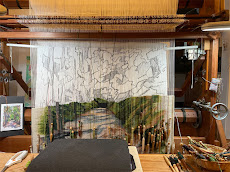Sunday, March 9, 2014
Stones continue to develop
I'm putting in occasional half-passes and passes of single yarns on top of a pick that's in place... those are being pulled from the gray bundles that are hanging at the top. And they're hanging on a raddle that I've tied to the top of the beater to have handy pegs from which to hang either these yarns or the bobbins as I get them up and out of the way so I can see what's going on.
This Ruthie loom (very similar to the Fireside Traditional Tapestry loom) has a beater that holds a reed through which the warp ends pass. I don't use the beater as such but do like to have the reed for spacing. The mechanism of the beater is such that it has a counter weight at the rear of the loom and so the beater will stay to its highest point easily--which is where I need it as I weave. My cartoon is hanging over a PVC pipe that's tied to the beater.
Tapestry is such a simple weave. Tools like the loom used by the weaver can be very simple, as well. Put a frame loom together, pound in some nails at top and bottom, string thread up and down--and you've got a tapestry loom. Yet the loom can be a bit more complex. Looms that are designed and made by companies specifically for high warp tapestry weaving aren't as numerous as floor looms, however. I happen to have several types made by different companies, a couple that aren't produced anymore. Almost all of my looms were previously owned by one or more people through the years. Each of them have their quirks and I enjoy the way some of them function more than others.
Rebecca Mezoff is writing about tapestry looms at her blog. Here's a link to her initial post about this and she'll be posting more about it all in the future. Follow her interesting and informative adventure in compiling information about tapestry looms!
Subscribe to:
Post Comments (Atom)








No comments:
Post a Comment